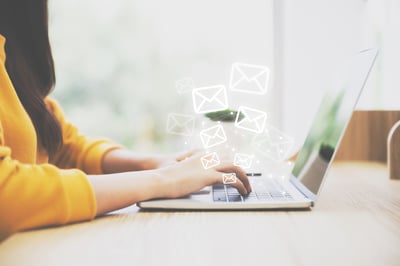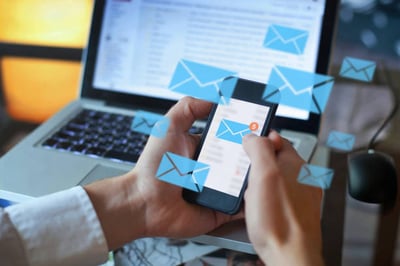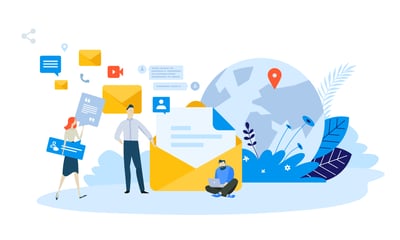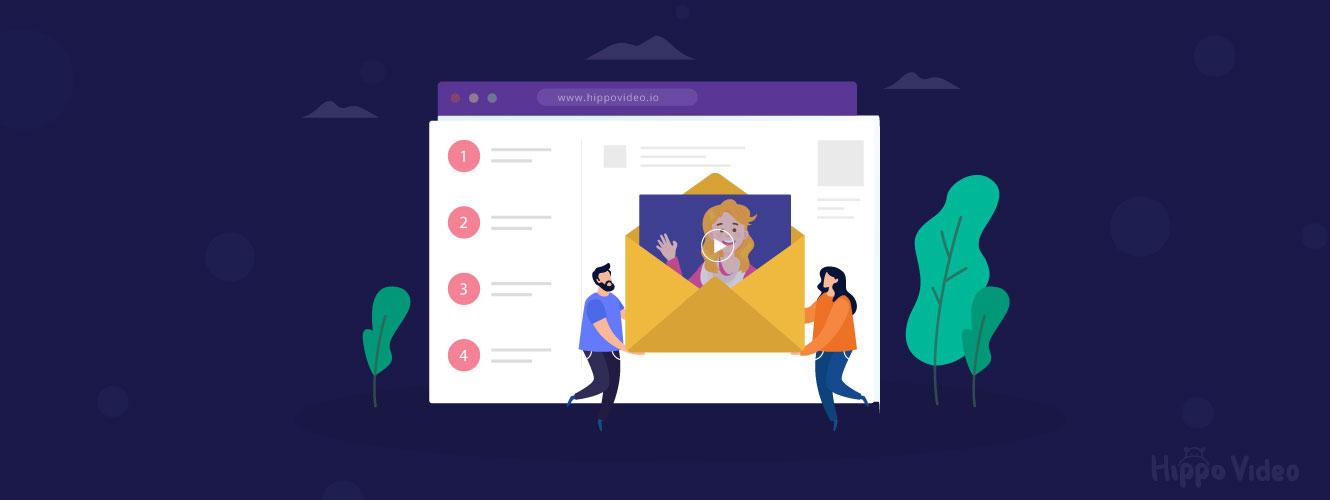

In a world where email marketing campaigns dominate every marketing effort and inboxes are filled with newsletters and offers, relevant and personalized email campaigns have become necessary.
Email marketers, and marketers in general, aim for a more friendly approach powered by customer experiences to increase customer engagement and their brand's revenue with email marketing software.
But how are personalized email campaigns possible? Let's see.
Email personalization is a technique marketers use to create an email campaign targeting a specific subscriber segment in their subscriber base.
It can be as specific as creating content stemming from a direct user action, such as sending a cross-sell email with products they viewed on your website, or as broad as using a segment's location to show them relevant content.
The email content created for personalized email campaigns comes from customer data platforms. In other words, everything your users and potential customers share with your brand in terms of information and actions that could help you boost your conversion rate.
You can personalize email campaigns in many ways, as some of them need to be more personalized than others. However, personalization has some staples.
Of course, email personalization can be as generic or specific as a marketing plan allows at that particular point in time. It can include something as simple as the recipient's geographical location or as complicated as their preferred device or dynamic content that changes according to the products they viewed on your website or the time they spent on a specific page.
Marketers usually implement demographic and psychographic data to personalize email marketing campaigns and drive more conversions.
Source: Hygge Creative
Demographic data describes data associated with a person's "tangible" identity: their gender, age, financial and educational status, and so on. On the other hand, psychographic data includes less tangible things, such as interests, opinions, thoughts, hobbies, and aspirations.
Marketers use demographic and psychographic data to segment their audiences and decide about anything personalizing an email.
These elements include, but are not limited to:
Presenting your brand in a way that seems natural to each customer using personalized emails can warrant the following:
Source: Oberlo
Email open rates are 20% on average. Now, personalization can boost this open rate by 50%, which doesn't come about that easily.
The statistic above stems from the fact that a personalized email is something a subscriber expects to see, in some ways. It's like opening a dialogue with a friend who knows them very well and speaking on a one-on-one basis with each of them, including mentioning their name or specific interest.
This means that your email campaign needs to include relevant content and answer a specific question or cover a particular need.
Of course, this cannot happen without the right email outreach tools. Invest in an email newsletter tool to access email newsletter templates you can customize according to your data. Also, make sure the tool you pick includes automation options to streamline your strategy and use your prospects' actions to your advantage.
Dynamic content options and custom fields are also features that benefit your email customization and personalization efforts down the line.
All in all, creating targeted messages for your email marketing campaigns can help you reach your goals and key metrics, especially when you know the elements a successful personalized email campaign entails.
As mentioned above, the level of personalization of an email marketing campaign may vary; however, some elements are undeniable staples.
Customer data is the best place to develop content ideas for your email marketing campaigns. You can use demographic, psychographic, and dynamic content to show users exactly what they need to see.
It's the type of content used in tandem with static (unchangeable) content. It can change according to the email's recipient, their preferences, and even their behavior on your website. It aims to create a more personalized and complete brand experience and help marketers send mass emails that don’t compromise this experience while saving them time.
The most simple example is the "Hello, [First Name]" in a personalized subject line. The [First Name] is a changeable field personalized according to user data.
While dynamic content can go a long way, and it's a surefire tactic for any email marketing strategy, you can consider more personalization elements. Triggered email campaigns are vital to increasing your open and click-through rate (CTR).
It occurs after a user has taken a specific action – or trigger action – on your website. The trigger action sets off an automated email campaign that seems like a natural continuation of the user's activity.
Cart abandonment email campaigns are among the most common examples of triggered email campaigns since they're great for product recommendations and cross-selling or upselling opportunities.
Let's revisit the email's subject line. It’s the first thing a user notices about your email, and it can make or break your email campaign, especially since there's a massive number of emails sent and received every day.
Source: Statista
This amount means that using only a first name without relevant content won't cut it anymore.
So, instead of the "Hello, John,” you could try something like this:
Source: Moosend
As you can see, the recipient's name is in the email's preview text rather than the subject line itself. At the same time, the subject line is about a topic that might interest them. These two factors ensure that the recipient opens the email and clicks through it to get to the article in question.
The only thing missing from this email is a "From" address that can’t be generic. In general, recipients need to feel like they're talking to their peers when receiving a personalized email campaign, rather than a generic "noreply@companyname.com". A personalized subject line could warrant more sales down the line, but nobody likes purchasing from a robot.
However, this is not just an e-commerce issue. Since a personalization strategy's objective is adopting a human voice while implementing automation and artificial intelligence (AI) to create spot-on experiences, your "From" address needs to be a little more sophisticated.
Source: Moosend
A brand that desires to speak to its customer one-on-one with targeted emails and exciting content needs to create a particular point of contact with its prospects. And this can be done when using a personal "From" address and establishing a connection, rather than being impersonal even if it's just one step of the way.
Recognizing personalization elements is relatively easy, especially for people part of the pre-email generation seeing and receiving countless email blasts.
However, before personalizing your email marketing campaigns, consider some basic steps. They're all about keeping a clean email list and attracting the right leads using targeted lead magnets.
Before going ahead with the ten main personalization strategies that are unconscious staples in every marketing tool and strategy, let's point out two key factors that make a difference.
The first one is attracting the right leads. Knowing how to build an email list from scratch can make all the difference when targeting and personalizing your email marketing campaigns. This is especially true when you're trying to get emails delivered to your users' inbox, rather than the promotions tab or the ever-dreaded spam folder.
Before even creating your first personalized campaign, invest in a marketing tool with features like interactive landing pages, subscription forms, and other options to create your email list.
Also, make sure to study and follow your brand's communication pillars and how these work in tandem with your customer personas.
Now, a lead magnet could be anything, from a freebie and a discount code for e-commerce to a free guide if we're talking about software-as-a-service (SaaS) businesses.
Incorrect email addresses and undelivered emails show internet service providers (ISPs) that you acquire your email list using nefarious methods, even if you use all of the lead generation strategies at your disposal. Not maintaining a high-quality email list nullifies all personalization purposes.
Knowing what your ideal audience looks and sounds like makes talking to them a lot easier. However, identifying and segmenting it helps identify your ideal customer; moreover, it allows marketers to see whether their audience falls into their perfect customer category.
Source: entrepreneur.com
Age, gender, income, location, even personal interests form and shape your customer personas. In turn, these personas shape your marketing messages and offers, even the channels where you distribute these messages and your brand’s tone of voice.
Different age groups frequent different channels. It only makes sense for brands to promote their content straight to their target market’s platforms. Look at this chart:
Source: Marketing Charts
If a brand's audience belongs in the 18-29 age group, YouTube video content makes a lot more sense than a LinkedIn post on the same topic.
For marketers, knowing who’s interested in interacting with their brand and the type of content to engage them is of great importance. Of course, pinpointing what makes up an ideal customer isn't easy. Suppose you're unsure what content would attract their attention. In this case, you could always create a poll or a survey. Use it to ask your existing users what they love about your brand.
After that, analyze their answers and create content that resonates and naturally leads potential subscribers further down the funnel.
Another beneficial way of creating customer personas and looking into the content that would benefit both the audience and the brand is to look into the competitors' content marketing strategy. What are the keywords they're targeting? What content types are they producing based on those keywords?
Answering these questions allows marketers to understand their audience and what they're looking for and beat their competitors using the same fruitful tactics.
However, many marketers shy away from keyword research. The main reason is that they fail to realize that keyword research is a long process that won't give results right away and can be done, at least initially, without using paid tools.
Competitors' content consists of keywords that answer the prospects' questions as Google does. So, to understand the audience that reacts to competitor content, studying Google results is imperative.
A Google search can help marketers discover more keywords to help them understand what their audience is interested in and boost their conversions down the line.
Then comes audience segmentation. Any parameter can become a segmentation criterion, from geographic segmentation to browsing history, even the engagement rates on social media posts.
Of course, for this step, marketers should always consult their analytics and make educated decisions. A criterion that might seem fitting may not be what your audience has in mind at that specific point in time.
After identifying your key demographic’s traits, you need to create engaging email newsletters to lead prospects further down their respective customer journeys.
Choosing the right Email Service Provider (ESP) is paramount in this case, both because of the features and the better deliverability rates it can provide.
One of the core features of an email marketing and marketing automation tool that can help you with list building, as mentioned before, is a sign-up form or a landing page feature. However, creating a landing page or a subscription form won't attract leads in and of itself.
After understanding their audience and how it falls into their ideal buyer categories, marketers create content that resonates with them.
Sign-up forms and landing pages need to have understandable, lucrative content that catches a prospect's eye. Suppose your audience falls into the 18-29 age group as discussed above. In this case, marketers should look into video content for landing pages, as video is the content form that interests them the most.
The general idea is to create content, offers, and incentives attractive for your audience while promoting your product and service.
But even so, your audience needs to understand what their next step will be.
Source: p80
A CTA needs to be understandable, with colors that pop and actionable verbs that showcase what a user's next move should be. And, as you see, combining videos and CTAs works beautifully.
Another thing marketers need to keep in mind is that their content needs to be unanimous on all platforms. But what does that mean?
Let's assume that a brand creates a product video for its landing page. For this, a product’s social media post could lead social media followers to this landing page.
The same can be done through your email's signature if you're creating outreach campaigns and want to attract new sign-ups you've already contacted for various reasons. This list-building technique could prove to be especially useful for B2B professionals.
No matter how prospects visit your landing page or subscription form, the first thing to keep in mind should be to keep things interesting. Use interactive elements like quizzes to lead users to a specific result and improve the time spent on your page. This keeps your brand top-of-mind and shows search engines that your content is valuable.
The first one should be a given. Incentivize the effort if you'd like, and penetrate your existing prospects' social circle. After all, everyone likes being a brand ambassador, especially when there's a prize to be had.
Digital marketing is the best place to start branching out and approaching interested audiences familiar with your brand.
As far as the GDPR is concerned, educate your audience on what happens with their data. People are very mindful of giving their email addresses, names, or phone numbers, and a breach of customer trust can also lead to a massive loss in conversions further down the line.
After creating your email list with personalized lead magnets and attractive landing pages, your audience should be ready to receive your first personalized email newsletter.
One of the most common personalization techniques is using the prospect's first name instead of "Hey you" or "Hello, customer". If an email is the digital marketing equivalent of a knock on the prospect's door, it only makes sense to use their first name or something just as personal as a product from a previous purchase.
However, sending a personalized newsletter without a previous user action doesn't make much sense. This is where automated personalized email marketing campaigns come into play.
As mentioned before, specific user behavior can trigger email automation. Automated email marketing campaigns are lovely for some upsell and cross-sell action.
Of course, it's up to marketers to decide what a trigger should be. It could be something as tangible as viewing a specific product on a particular page or something less tangible, like the date of birth they entered upon signing up or the perishable goods they may be purchasing from your website.
Source: Clinique
This example is one of the best automated, personalized campaign examples. As you can see, it not only mentions the replenishable goods but also creates an upsell or cross-sell opportunity with relevant products the recipient will love since they’re frequent buyers.
And don't forget the power of reviews.
Source: PixelPoynt
As seen above, prospects look into their peers’ reviews to determine whether a product is for them, and the vast majority trusts customer reviews. This is the reason why a personalized email marketing campaign asking for your existing customers' opinions on your services is crucial.
As mentioned above, dynamic content can co-exist with static content and create unique personalized messages for your email marketing campaign recipient.
Source: Timberland
Weather-based emails are a prime example of dynamic content providing the most relevant personalized marketing message. Timberland's email above is a fantastic example. Using dynamic content that you can change in real time, as Timberland did, is a personalization technique guaranteed to boost sales.
This email showcases a real-time problem and proposes a relevant and to-the-point solution, taking a marketing trend, such as real-time content, and turning it into a profitable personalized newsletter.
Of course, an image is not the only thing to personalize when creating a custom user experience. Your email copy needs to be personalized as well, seeing as you're talking to different people from different backgrounds, time zones, and locations visiting your website.
This is why you should track and trace user behavior before creating email content. Apart from obtaining unique insights into the likes and dislikes of those interested in your product, tracking user behavior can also give you one-of-a-kind ideas when creating content.
Personalization tactics can – and should – go beyond personalized content and subject line. After all, marketers need to create a unified experience unique and special to each customer to stand out.
Since many businesses use digital marketing to build an online community, and email marketing is a component of digital marketing, making prospects feel like they're talking to someone they know is something that makes sense.
This is why sender details like info@yourbusinessname.com are not the way to go.
Source: Moosend
The consensus is that email marketing campaigns need not feel robotic. Audiences can turn to someone behind the personalized email campaigns they can talk to if they need more clarification.
Using their name and interests and your name and your interests creates a bond and keeps your brand top of mind, as you're becoming a familiar person, a "friend,” rather than just an impersonal organization.
A personalized product recommendation is something that can go a long way. Making great use of your CRM allows you to create content based on what your users check out and eventually buy.
You can segment your list and personalize your content according to age, gender, location, weather conditions, even their interests, and past purchases.
Personalized product recommendations can also decrease cart abandonment while increasing your customers’ average order value and conversion down the line.
Of course, recommending just any product won't do you any favors. You need to remain relevant and to the point with what you're offering. This is true for your audience and your brand's values that need to resonate with your audience.
Sending an email at just the right time is an integral part of your overall marketing efforts, especially when talking about eliciting an emotional response for lead generation. But what is the right occasion to send a personalized email marketing campaign when your audience is as versatile as your brand?
The right location can create email content and offers right off the bat, primarily if your audience is spread around the globe and you're not just working locally. This is especially true for e-commerce brands shipping all over the world.
Holiday email marketing, after all, is an excellent chance to generate leads and content. And regional holidays with super-relevant email content provide a brilliant opportunity to utilize email content.
Just keep in mind that this type of content resonates only with users from a specific region. For example, if a good chunk of your audience is located in China, making use of the Chinese New Year would be a smart move to provide super-specific special offers and benefits.
The same goes for US holidays, like the 4th of July, or India's Diwali.
As mentioned above, a behaviorally triggered email can help you communicate with your audience by responding to their needs and actions on your website and email marketing campaigns.
An anniversary email, a cart abandonment email, a replenishment email, and a welcome email stem from a user's action. This is one step toward hyper-personalization and creating a healthy dialogue with your audience.
Automated emails, especially those from a behavioral trigger, streamline your actions appropriately, save your marketing team time and effort, and create meaningful interactions with your brand.
But let's look into the different categories of triggered emails:
Triggered email marketing campaigns give users a unique opportunity to engage with a human brand and interact with it. It's almost like talking to a friend or a dedicated agent.
These techniques ensure hyper-personalization bringing about more leads, better customer experience, leading users further down the sales funnel, one step at a time.
Hyper-personalization can also keep a brand top of mind and boost loyalty, authority, and recognition. Provided, of course, you have the correct data to do so.
Source: Statista
AI and data are essential to ensure your personalized email marketing campaigns score all the goals and key performance indicators (KPIs) you've set when planning your marketing campaigns. Not to mention, they improve your overall digital marketing efforts.
As mentioned above, a personalized landing page with interactive elements with just the right product recommendations, a personalized explainer video to help with gentle email advertising, especially if we're talking about the marketing plan of a small company, all goes beyond an email.
Especially if one considers that the model now is neither B2B nor B2C; instead, it's H2H (Human to Human).
Marketing automation pinpoints the ways marketers use software to streamline their activities and save time, effort, and resources.
Marketers in both small businesses (SMBs) and Fortune-500 brands use marketing automation to "set and forget" repetitive tasks, like email marketing campaigns and follow-up emails that look and feel authentic and human, social media posts that score a lot of engagement and triggered campaigns that inspire audiences.
Marketers need to create segmented lists appealing to each target customer persona: timely, relevant, and interesting to achieve these goals.
This is why automated segmentation is important. AI and machine learning can assist a lot in this aspect, with laser-targeted product recommendations that appeal to each customer on a one-on-one basis.
Some brands have personalization pinpointed and down to a tee. Then some go beyond personalization, with clever segmentation and automation techniques that work like a charm and make users feel special while generating high levels of engagement.
And there's no better public relations (PR) plan than creating an emotional response, prompting your users to promote your brand by sharing their experiences. So, let's see the brands that nailed it.
Spotify created one of the smartest personalized email marketing campaigns.
Source: Spotify
Essentially, this function allows the user to look at their musical preferences while using the popular streaming app, gain insight into various times when they preferred X over Y genre, and perhaps look into their past and feel inspired to set new goals in the future.
The copy is clever and pops out with words like "Unwrap" or "Guess" that make a huge difference to users and spark curiosity while giving the app some extra opportunity to discover new trends.
EasyJet's personalized email marketing campaign in 2015, titled "How 20 Years Has Flown," is a case study for hyper-personalization everywhere, primarily because hyper-personalization was simply optional at the time of the launch.
Source: EasyJet
This campaign showed EasyJet customers how they'd used their aviation services, making the popular company a household name. This was precisely when air carriers were trying to lose their "luxury" standards and become more affordable and accessible.
EasyJet's expert use of data made all the difference and paved the way for all brands to create personalized experiences. The email tells a story that has nothing to do with the brand itself and everything to do with the user's experience.
Sephora encapsulates all personalization efforts in a personalized email marketing campaign series that can work like a charm for every triggered action.
Source: Sephora
From welcome emails to creating experiences with freebies, incentives, and replenishment actions, the beauty brand is an expert at targeting its customers and gently leading them down the funnel.
The brand also encourages users to write product reviews through personalized email marketing campaigns. This little action goes a long way for brands that care for their customers and create transparent experiences.
Lyft's case is a little more intriguing than Spotify's "Year in Review" efforts, seeing as the brand isn't one to non-transactional send emails or have nothing to do with the service itself.
However, their 2018 campaign nailed the efforts with helpful information on using the brand's services and information about the company and the recipient's preferences.
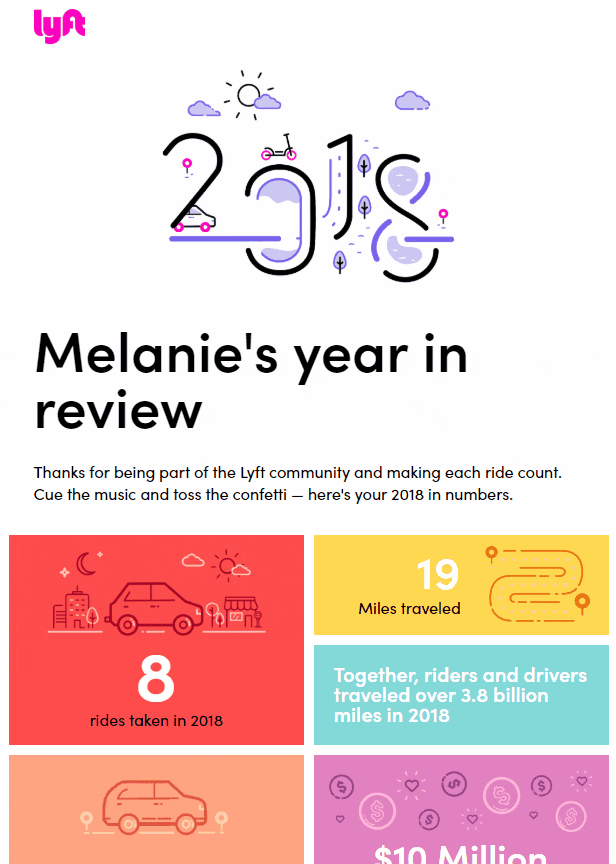
Source: Lyft
Much like EasyJet, Lyft's personalized email campaign creates content that stems from a user's action. It resonates with them rather than plainly showing them how beneficial their service is. And much like Spotify's example, this email's content allows users to look into their actions, set new goals, and understand their preferences while interacting with the service
Personalized email marketing campaigns make all the difference, boost a brand's authority, and benefit user interactions, SEO efforts, social shares, and, ultimately, conversions.
However, personalization doesn't come on its own and won't work in and of itself. Segmentation before personalization and always according to your audience's needs and buyer personas is essential to nailing your efforts.
Combine performance and segmentation data to provide personalized experiences using A/B testing software.

Personalize and automate your email campaigns with email marketing software.
Téa Liarokapi is a Senior Content Writer for Moosend, an email marketing and marketing automation platform, and an obsessive writer in general. In her free time, she tries to find new ways to stuff more books in her bookcase and content ideas – and cats – to play with.

Personalize and automate your email campaigns with email marketing software.
One of the most efficient channels for communication, both inside and outside of an...
 by Alex Souchoroukof
by Alex Souchoroukof
The future of email marketing is here!
 by Aquibur Rahman
by Aquibur Rahman
Email is one of the go-to forms of communication for many companies who want to connect with...
 by Michael Bibla
by Michael Bibla
One of the most efficient channels for communication, both inside and outside of an...
 by Alex Souchoroukof
by Alex Souchoroukof
The future of email marketing is here!
 by Aquibur Rahman
by Aquibur Rahman
Never miss a post.
Subscribe to keep your fingers on the tech pulse.

